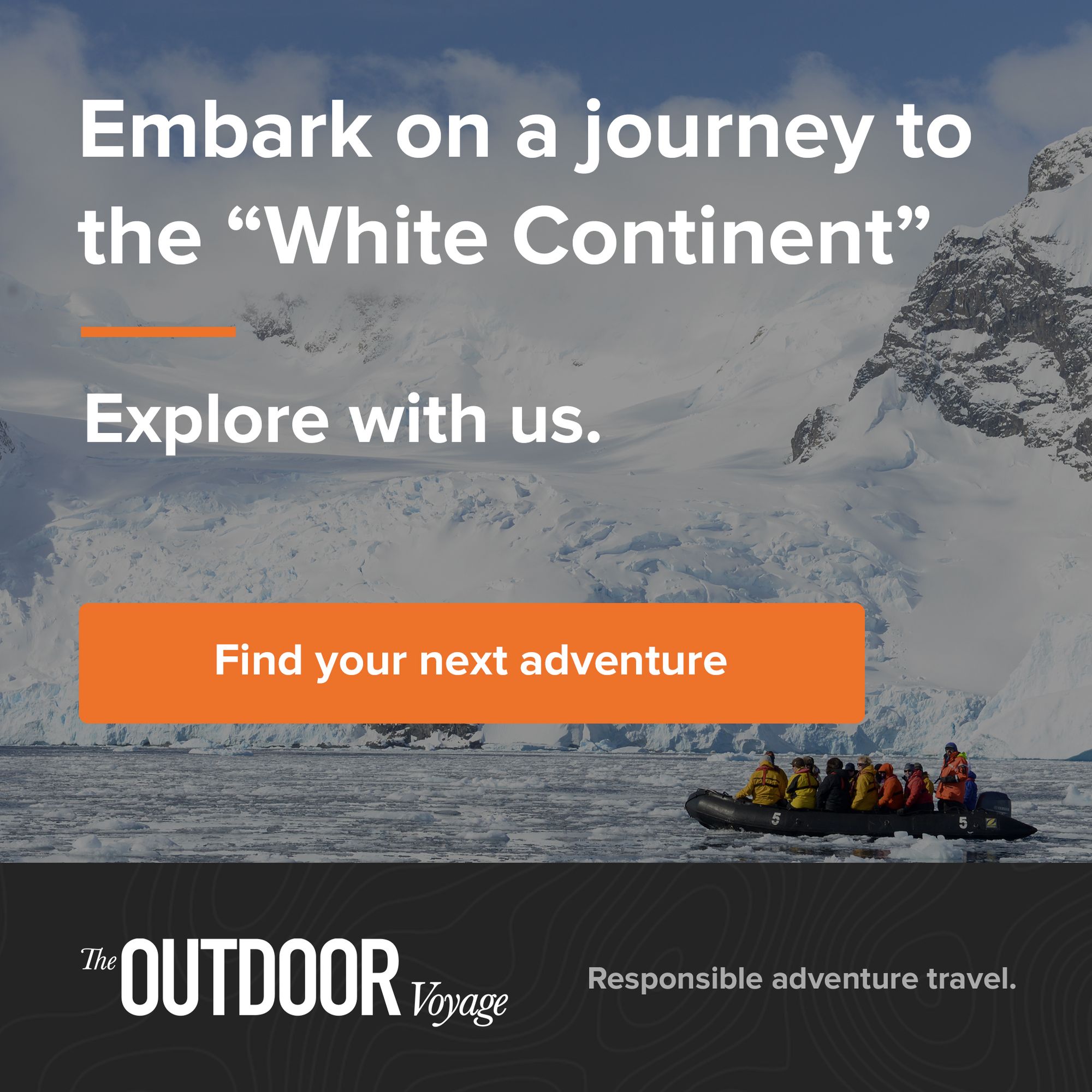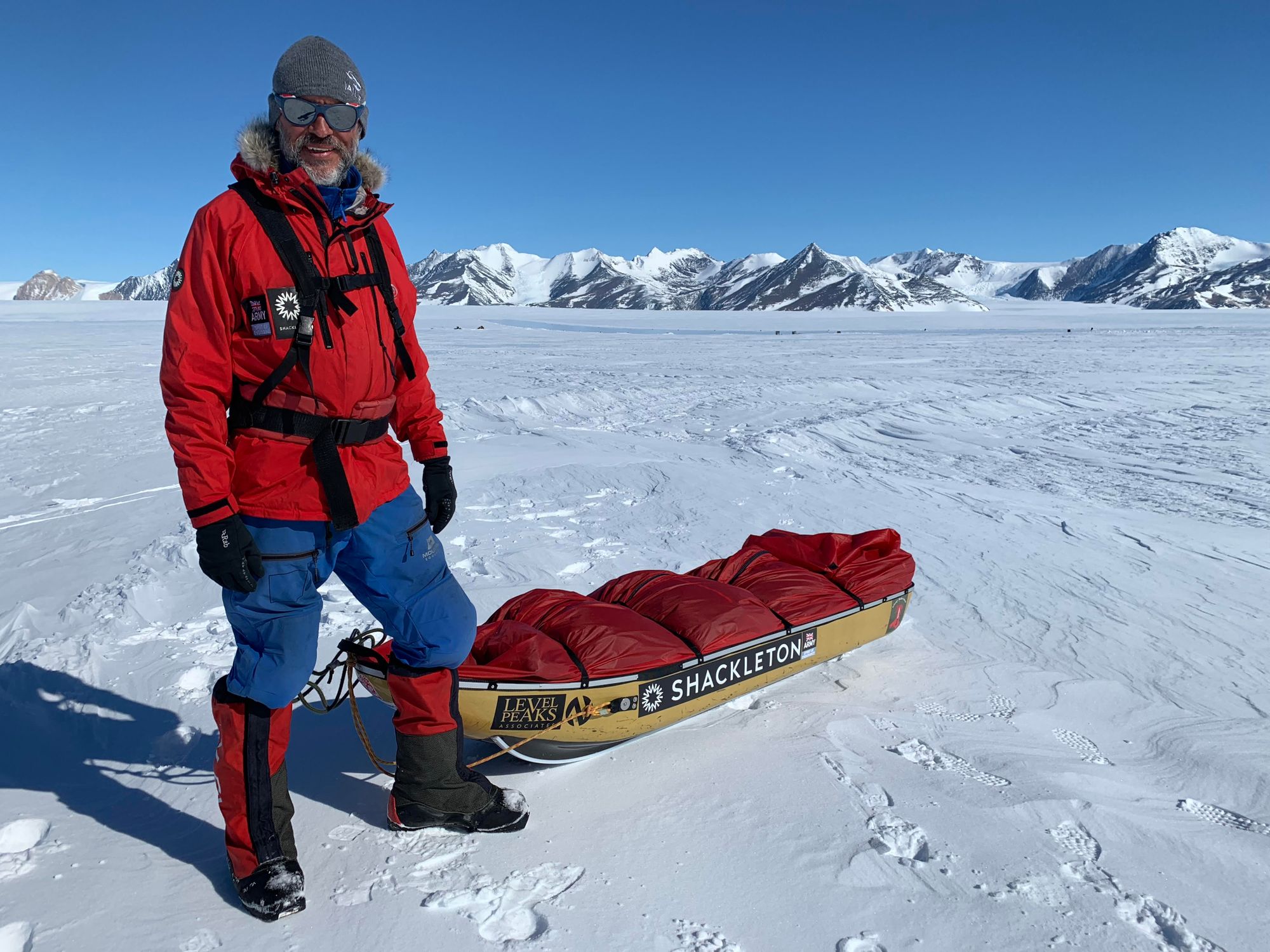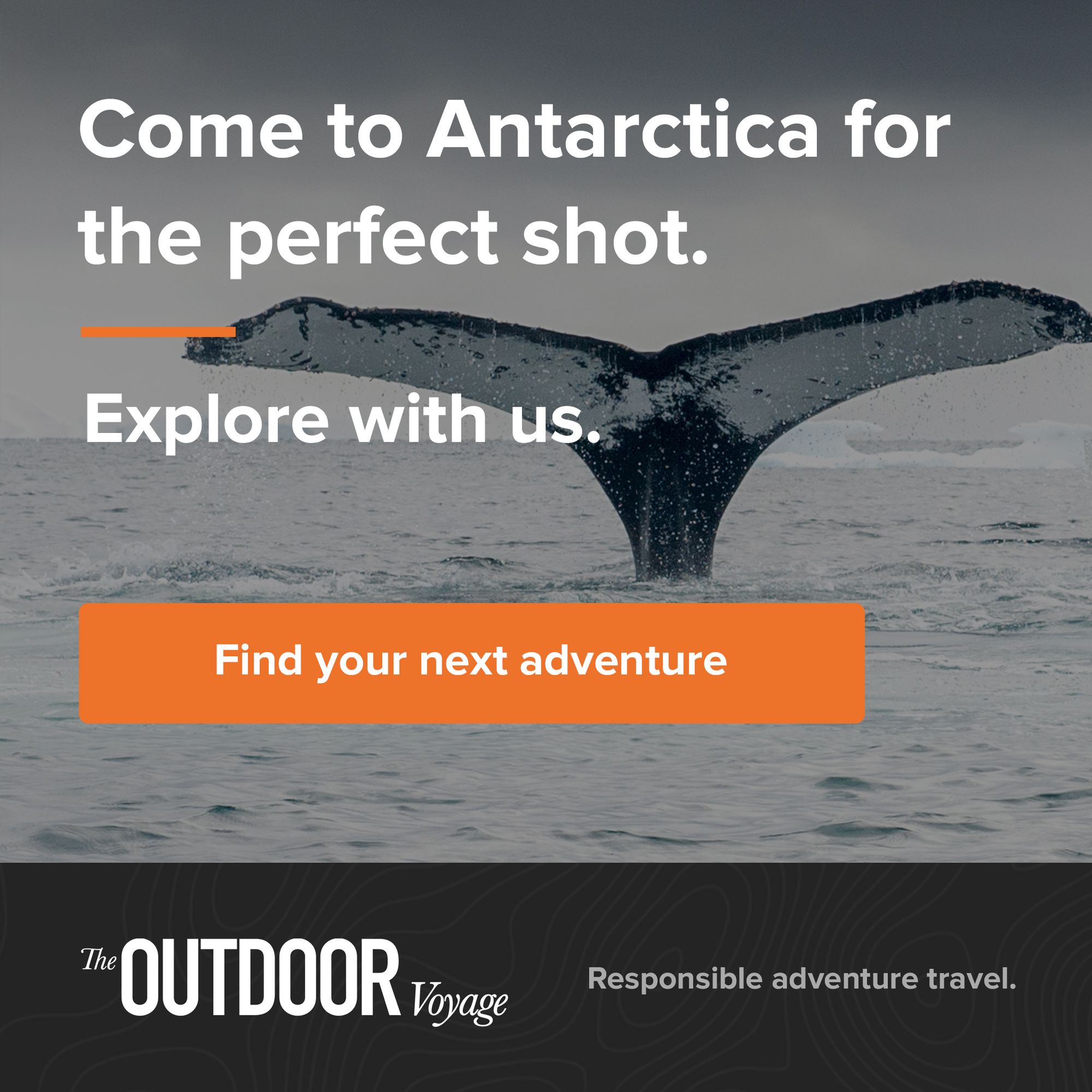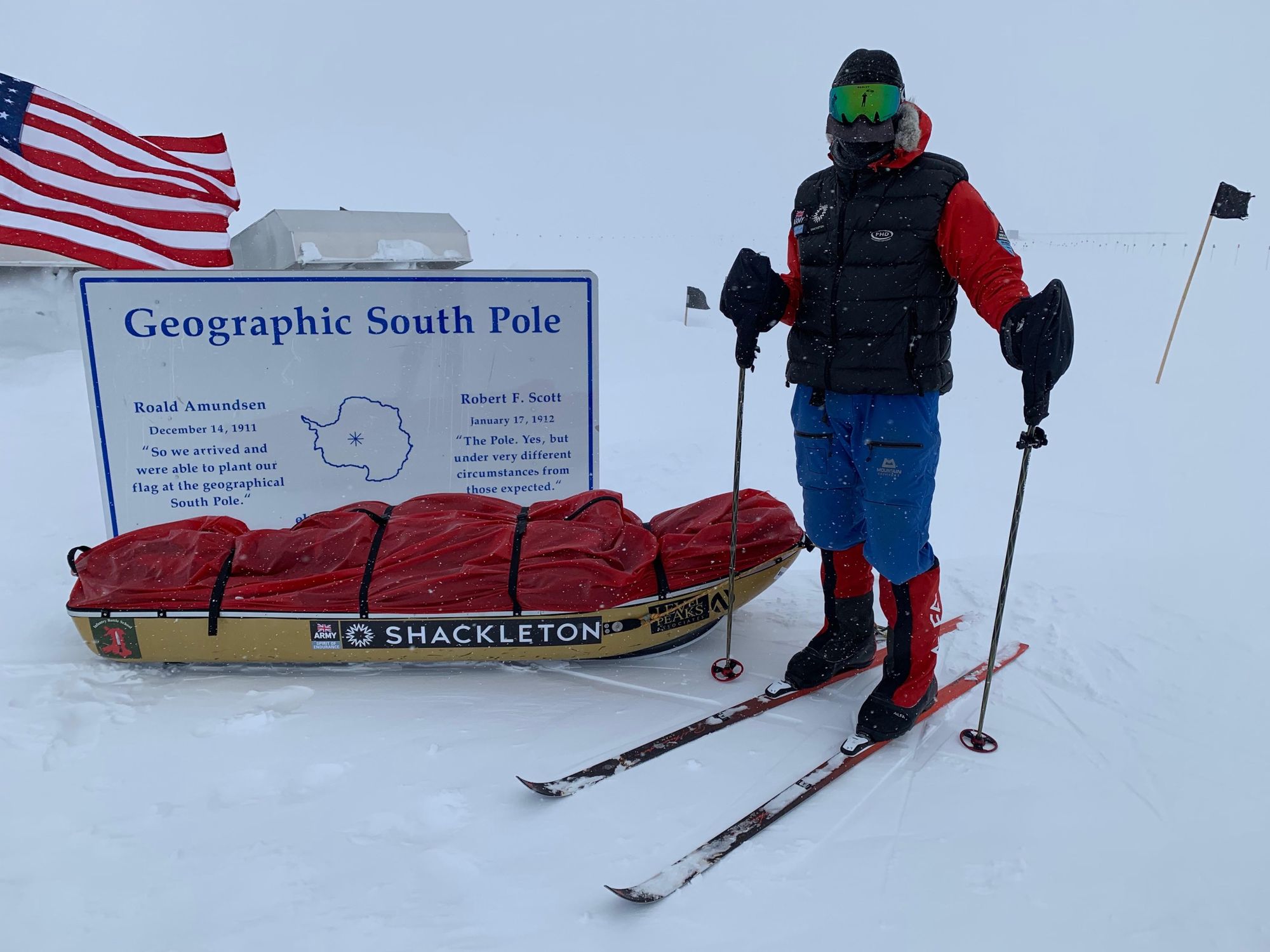Piolets d'Or Announces the "Significant Ascents" of 2023
This list of 68 climbs is effectively a "long list" used to select nominees of the prestigious alpine award.
In the harshest environment on the planet, Captain Louis Rudd becomes the first Briton to cross Antarctica on a solo, unsupported, human-powered journey.

In a 5-part series Alone Across Antarctica, The Outdoor Journal connected with the greatest living polar explorers to discuss their solo missions across Antarctica, where one mistake can have lethal consequences. In Part 1, Colin O'Brady discusses the unique challenges of his world record traverse compared to his other world record endurance expeditions. In this installment, Captain Louis Rudd reveals how his 33 years of military experience built up his mental and physical toughness to survive his 56-day journey across the most inhospitable terrain in the world.
Totaling more than 3,000 miles (4,800 km) on polar expeditions, Captain Louis Rudd is one of the foremost polar explorers on the planet.
On November 3rd, 2018, he embarked on his most ambitious challenge yet, to ski across Antarctica alone, with no food resupplies and no assistance.
Just five days before departure, Captain Rudd learned that he’d have competition on his journey, dubbed “The Spirit of Endurance,” which turned his personal challenge into what looked like from the outside as a two-man race for the record books. Along with Colin O’Brady, an American athlete and explorer, Captain Rudd boarded a Twin Otter aircraft from Union Glacier to the starting point at the Ronne Ice Shelf.

Battling 60 mph headwinds and six foot high snow-drifts in whiteout conditions, Captain Rudd navigated “an icy obstacle course,” as he puts it, over 930 miles (1,455 km) in 56 days. Captain Rudd hauled a 285 pound (130 kg) pulk, or sled, behind him which carried everything he needed to survive the journey, including food, tent, and kit. He spent 10-12 hours each day navigating deadly crevasse zones and avoiding sastrugi, but since every gram of gear counts, he only changed his ski socks once every 10 days.
On Day 46, he achieved his personal best of 23.4 miles (37 km), at over 9000 feet (2,700 m) in elevation with -30 degree windchill Fahrenheit. In the end, the impromptu competition between Captain Rudd became secondary, as he truly did it “for the love of the journey.”
The Outdoor Journal connected with Captain Rudd to discuss the most dangerous challenges of this expedition, how his military experience prepared him for this solo journey, the logistical nuts and bolts of preparation that allowed him to survive this seemingly impossible mission, and the unexpected media response to this new record.
TOJ: At what point did you find out that Colin O’Brady would be attempting the same journey simultaneously with you and did that turn your endurance challenge into a race?
Captain Rudd: I only found out about Colin five days before I left the UK to head out to Chile. He emailed me to introduce himself and explain that he was looking to do a similar journey. Obviously, it was a little bit frustrating purely because for a whole year I declared my intentions and put a website up and I thought I had a clear run at it. It hadn’t even entered my mind that anybody else would be down there at the same time taking the same journey. It’s a highly unusual situation that arises, probably not since Scott and Amundsen has it happened.
"Nobody’s ever done this journey before even though there’d been several attempts and my friend died attempting it."
I spoke with my wife and family and we decided that the sensible way to approach it was to focus on completing the journey. Nobody’s ever done this journey before even though there’d been several attempts and my friend died attempting it (in 2016, polar explorer Henry Worsley died attempting the same journey).

What I was really worried about was getting drawn into a direct race with Colin and overstretching myself, burning out if I pushed too hard and then not even finishing the expedition. Then if I happened to come in first, it would be a fringe benefit, a ‘nice to have.’ I wasn’t tracking Colin’s progress and even though my team was, I said to them ‘Don’t tell me anything about Colin unless I ask.’ We were both keen to preserve that solo element.
Then towards the end, I tried doing a bit of a night ski a couple of times to close the gap but I quickly realized I wasn’t enjoying the expedition anymore - skiing in a bit of a zombie, comatose state with the lack of sleep. And I didn’t do the journey to have any title tagged to me. I was purely there for the love of the journey.
TOJ: How did you feel about the age gap between you two (49-33)? Because you've been serving in the military as long as he's been alive and it's like one of those classic lines in a movie where a character says, ‘I've been running military ops since you were in diapers.’
Captain Rudd: I'm 50 years old next month. I have the experience on my side, I have a couple of thousand miles traveling Antarctica under my belt, whereas Colin is a very accomplished mountaineer but without specific polar experience and I actually thought his chances of successfully completing such an extreme journey were pretty slim. If you think of all the things that could go wrong, from gear failure to fuel spillage (which would force you to take a resupply), to injury and illness - I kind of thought that Antarctica would do the job for me when it came to the race side of it.
TOJ: What did you think of Collin’s final ultramarathon push, covering the last 77 miles in about 32 hours?
Captain Rudd: Yeah, that was just incredible. Pretty amazing actually. I probably couldn’t do that, if I’m brutally honest, especially at that stage right at the end. If my life depended on it, maybe, but I wouldn’t choose to do it. Hats off to him. He’s an extreme performance athlete.

TOJ: Hauling a 285-pound pulk, describe your relationship with it. Because it’s all your survival gear and also your burden to pull.
Captain Rudd: I absolutely loved my pulk most of the time. I've done quite a few polar journeys now and I’ve had a different pulk every time. It was of carbon-kevlar construction and only weighed seven and a half kilograms (16.5 lb) empty, which, for that size, is unbelievable. And it was 2.3 meters (7.5 feet) long, so it was the largest pulk I had ever pulled by a long stretch. And it had to be that big to fit 65 days of food and all the equipment that I needed for the crossing. It was expensive - like five and a half thousand euros, but it performed brilliantly. It never flipped over once through the whole journey. If it had flipped over, there would be no other teammate to right it for me, which can get exhausting really quick. It was one of the key factors to the success of my expedition.

With that said, I had a bit of a love/hate relationship with it at times. There were times going through deep soft snow when it would sink beyond its runners and the belly would drag slowly through the snow when I hated it. It was a huge strain around my shoulders and waist. But that was just the nature of the surface conditions. The way I viewed it, it was my life pod. It carried everything I needed to survive out there in a pretty inhospitable environment. Everything I needed was all self-contained for the duration of the crossing - food, safety gear, tent, sleeping bag, cooker, fuel. That’s an element of the journey that I really enjoyed - self-sufficiency. The plane drops you off, you’re on your own and that pulk gives you the ability to sustain yourself without any form of assistance or resupply for such a long period of time - to survive for two months in the harshest environment on the planet.
TOJ: You said that was your first time working with that pulk model. But something that you've had on every one of your expeditions is the harness “old faithful.” Have you developed a sentimental relationship with it?
Captain Rudd: Because it’s worked for me and never caused me a problem like chaffing or back pain, I thought, “Why change?” even though there are probably better, lighter models out there. It’s not just the expeditions, but it’s also made it through all my tire pulling training throughout the year as well.
TOJ: What day is the “sweet spot” when the pulk is lighter and you are still feeling good and not too fatigued?
"I trimmed labels out of clothing to save five grams."
Captain Rudd: You're exactly right. The pulk does get lighter. It’s a gradual process but yet at the same time, you're getting fatigued. But the reason that no one day is the sweet spot is because surface conditions continually change. When I was less experienced, I felt like I hit that sweet spot when there were only 20 days left of food and I thought the pulk would feel light the rest of the time. But then I’d wake up the following day and the temperature changed, the winds changed and there was more snowfall and the pulk would just feel horrendous again, dragging like a bathtub.
TOJ: I saw on one of your log updates that you were changing your ski socks once every 10 days. Couldn’t you have afforded another pound of gear to add a couple more pairs of socks in there?

Captain Rudd: The single hardest thing as for why this journey hadn’t been done before is the weight issue. Colin and I both went to great pains to save weight wherever we could. I was counting grams. If I could trim labels out of clothing and save five grams, I was doing that.
TOJ: If an accident happened where you get a rip in your tent to the point that it becomes unusable, do you have a backup means of survival to last through the night?
Captain Rudd: I’ve been in the military for many years and I’ve dug a lot of snow holes and snow trenches. If I got a tear in my tent, I do have a pretty comprehensive sewing kit that I got from repairing sails on yachts. But if my tent was completely unusable, my options would be to sleep in the pulk quite comfortably overnight wearing all of my kit or dig a snow hole with my snow shovel or dig a snow trench and put the pulk over that.
TOJ: Did your military experience serve you better in terms of skills like digging snow holes or in terms of overall mental toughness?
Captain Rudd: I think the 33 years I’ve done in the military definitely made me physically, and more importantly, mentally robust. During the journey, when I was having a hard time, I just kept reminding myself that nobody was shooting at me, nobody’s trying to kill me, I don’t have to wake up at 3:00 am to lay outside the tent on sentry duty - the kind of stuff you have to do in Norway on exercise - it’s just cold weather camping.
TOJ: Can you describe the specific training regimen that you did to prepare and also how did you make sure that you didn't overtrain?
Captain Rudd: For me, strength and conditioning in the gym - deadlifts, squats, combined with tire pulling, hill walking with a loaded backpack, swimming, cross-country running, and then I went out to Norway in February for two weeks to get in a bit of time on skis with my camping gear and kit. And the main thing I did as a great benefit was a 570 kilometer (354 mile) traverse of the Greenland ice sheet in May. That was a great confidence builder because I felt like I could have turned around and gone back again if I had to.

TOJ: How would you describe the difference between a team like you’ve done on expeditions in the past versus going out on your own this time?
Captain Rudd: The biggest disadvantage when doing a solo expedition is that there is no respite for being up front. It’s relentless. You’re breaking trail through soft snow all day, you’re the only one responsible for concentrating on skiing straight lines and navigating. Solo in a whiteout is when it becomes most difficult, staring at the compass for 12 hours, you can’t see the terrain you’re going over, no reference point, stumbling over sastrugi, it’s just mentally draining.
On the plus side of the solo experience was, number one, I wasn’t responsible for other people, so that’s less of a mental burden. Number two, your speed of travel is limited by the slowest member of your team. I really enjoyed the freedom of the solo journey being able to ski as long as I wanted to with flexible breaks.
TOJ: One of my favorite details that I read about your journey was that you used your own shadow as your navigation guide and only paused to re-calibrate your compass every hour.
Captain Rudd: You can pick any timezone when you’re down there to travel in and I picked Chilean time because I knew then that would put the sun behind me throughout the whole ski day. On the non-whiteout days, I could follow my shadow all day and ski a straight line, it was fantastic!
TOJ: For people who have never been to the poles and who never will go, how would you describe the beauty that you see in the landscape?
Captain Rudd: It's just stunning. You get this sense of vastness. It’s twice the size of Australia. As the light conditions change you get all sorts of different shades of light. You get some stunning cloud formations, I’ve never seen these style of clouds anywhere else on the planet. Even in the sastrugi, you see all different shapes from cars to people’s faces, all carved by the wind. You see halos, these parhelions that are big rings, like rainbows around the sun. You’re also conscious as you’re skiing along that most of the time you are probably the first ever human being to ever actually place your foot in that particular spot. The other thing that I like about it, which I guess might be slightly odd, is you’ve always got this weariness in the back of your mind that one mistake down there, particularly solo, the environment will punish you pretty quickly, and it could be lethal.

TOJ: There's been a variety of different route attempts from Amundsen to Messner to Børge Ousland and Mike Horn, etc., and then you have this most recent crop of expeditions with Ben Saunders, Henry Worsley and then yourself and Colin all choosing this new modern route. Can you describe your process of deciding where to start and finish?
"We were claiming that we were the first to do it in that particular way - unsupported. No kites. No resupplies."
Captain Rudd: I’d like to start by saying I have massive respect for the other soloists. We get misrepresented by the media who don’t understand the intricate details, but we weren’t claiming the first solos across because obviously Børge Ousland and Mike Horn had done some amazing journeys down there. Børge soloed right across the continent. I’m a huge fan of Børge’s. I have a massive amount of respect for him. Mike Horn as well, I’ve met them both. What was different about our journeys was the style. We were claiming that we were the first to do it in that particular way - unsupported. No kites. No resupplies. We both researched it to make sure we were 100% correct that nobody had skied across unsupported with no resupply and we were correct in that. What Børge did was an incredibly huge distance (1,768 miles). And Mike’s distance was absolutely vast (3,169 miles). You could only do those journeys with a kite. It’s as clear and simple as that. And the analogy I use is the difference between rowing across the Atlantic ocean or sailing across the Atlantic ocean. People can clearly see in their head that if you’re in a rowboat, it’s much slower and much more difficult and physically challenging to row across the Atlantic ocean than it is to sail across. I’ve done kiting and I know the huge distances you can cover and physically how less demanding it is.

So it wasn’t even an option for me and Colin to start out on the actual ice shelf. We couldn’t do it because there wasn’t enough time available, there are only 90 to 100 days at best in the expedition season. We also couldn’t do it because of the logistics operating now. You’ve got one company ALE that does the logistics support, flies you to your start point, provides your emergency cover, and picks you up at the end. For insurance reasons now with landing the plane in prepared areas and reach of the aircraft, they don’t give you the option to be able to fly out to the coastline like they did back in the ’90s. Mike Horn got around it via his yacht. He’s a full-time adventurer so he’s got his own crew to land him on one side of the continent and pick him up on the far side when he finished the journey. So we went with one of the central points that’s been viewed as the coastline of Antarctica for the last 20 years - the Messner start. And the Ronne Ice Shelf and the Ross Ice Shelf are frozen sea ice, they are giant frozen bays (Ross Ice Shelf is the size of France). In the modern era, everyone says that’s the actual coastline of Antarctica. I’ve done the ice shelves before, back in 2011 before this insurance issue, me and Henry (Worsely) did get dropped off at the Ross Ice Shelf, the Bay of Whales, where Amundsen started. And I have skied past the whole Ross Ice Shelf, but now it’s just not feasible for a crossing.
I believe, if you use a kite, you can’t claim “unsupported.” For me it’s crystal clear, if you use a kite and harness the wind, you get pulled along, that is a supported journey, plain and simple. There’s an element of jealousy in the media coverage we had, which we never asked for, it just materialized.
TOJ: In your logs, each day you were describing the whiteout conditions with sastrugi that made you fall face-first where the impact was so hard that you cracked a ski, but some of the past explorers like Aaron Linsdau and Eric Philips have commented that the South Pole Overland Traverse is groomed and marked, but that seems like a discrepancy to your experience.
"Hauling 130 kgs over 900 miles across the continent was horrendously difficult, hence why no one had ever managed it before."
Captain Rudd: Eric Philips and others are commenting that haven’t skied on that South Pole Traverse route, and I hadn’t until this journey, so I had no idea what to expect. Having now skied over 3,000 miles, I think I’m in a good position to comment. People are claiming our route is not unsupported because of this South Pole Traverse route, which runs from McMurdo on the ledge of the Ross Ice Shelf up the Leverett Glacier. My reason to go for this route was safety. Speaking to the expedition company ALE, for a solo, they said from the pole go down the Leverett Glacier because the crevasse risk is well understood, and it’s traversed by vehicles so we minimize the risk. You get on it and it’s a pretty churned up mess. It was quite hard to tell the difference between the supposed track I was on and the edge. And then partway through the journey on the traverse, the vehicles came through, they passed me dragging fuel bladders and stuff.

For the first hour, it was great because they sort of flattened it out, but it was quite a windy day and after that hour it filled in with soft spindrift and it really hampered the progress, so I ended up skiing just off to the side of the traverse. I skied parallel to the traverse because the vehicles churned it up, it was just rutted, filled with spindrift and it was actually a pretty crappy surface. So this big myth that it’s some flat ice road is complete rubbish. The other thing that was brought up was the little bamboo poles with a flag in it every 400 meters. They were handy, but I still had my compass on. And by the time I got to that track, I’d previously skied 2,000 miles across Antarctica without bamboo poles and never had a navigation issue, so they didn’t make any difference. I certainly wouldn’t want to use it again to be honest.

TOJ: Now that you're getting hounded for media requests and everyone asking you for your attention, do you ever wish that you were back out in isolation?
Captain Rudd: (Laughs), I prefer being on the expedition to the post-exhibition piece, but I don't mind the expression of interest. I’m pretty staggered by how much media interest there has been for this particular journey. I certainly don’t do these expeditions for any sort of recognition. I do it for the love of the journey.
TOJ: How have you reacted to the response by the polar community?
Captain Rudd: I’ve got a huge amount of respect for those guys who went before us, it’s just slightly disappointing that the one grouping, the polar community, that could truly understand what me and Colin did down there, which was an extremely brutal and difficult journey, that these are the ones that are actually being negative about it. Hauling 130 kgs over 900 miles across the continent was horrendously difficult, hence why no one had ever managed it before. My only explanation for these few negative detractors boils down to professional jealousy - they’re worried about us sneaking slots on their circuits.
TOJ: I think part of that negative reaction might be the nature of social media today.
Captain Rudd: Yeah, because the media spun it as a race, that’s what made it of such high interest. But for me, if it’s put polar travel and Antarctica back in the headlines, it’s a good thing for everyone.
To learn more about Captain Rudd's journey, check out his website "The Spirit of Endurance."
Follow along with Captain Rudd's daily logs here.
Stay tuned to The Outdoor Journal for the next installment of our Alone Across Antarctica series.
Whilst you’re here, given you believe in our mission, we would love to introduce you to The Outdoor Voyage - our booking platform and an online marketplace which only lists good operators, who care for sustainability, the environment and immersive, authentic experiences. All listed prices are agreed directly with the operator, and we promise that 86% of any money spent ends up supporting the local community that you’re visiting. Click the image below to find out more.

2nd best newsletter in the universe